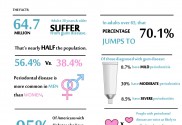Charting the Ecology of Gum Disease
- Jason Schwartz
- Aug 27, 2016
In research published in Applied and Environmental Microbiology, an international team of researchers and clinicians charted the microbial ecology of the mouth at all stages of this progression, in nearly 1,000 women in Malawi where oral infections are very common.
The investigators used high-throughput sequencing of the 16S ribosomal RNA (16S rRNA) gene to take the census of the oral microbiomes—the combined genetic material of oral microorganisms. When they analysed this, they found that a small number of bacteria were associated with periodontitis, but not gingivitis.
“Our findings confirm that periodontitis cannot be considered simply an advanced stage of gingivitis, even when only considering supragingival plaque,” said author Liam Shaw, a PhD student at University College London, UK.
Diagnosis requires specially trained dental professionals and expensive equipment, which are seldom available in developing countries, added Harjunmaa, noting that this research may in future lead to an inexpensive and rapid point-of-care test, based on distinguishing the microbiomes associated with both conditions.
“The research made it possible to tell which differences in bacteria were linked specifically to the deepening of dental pockets—which causes loss of teeth— rather than just to bleeding gums,” said Shaw.
For the full article, click here.





